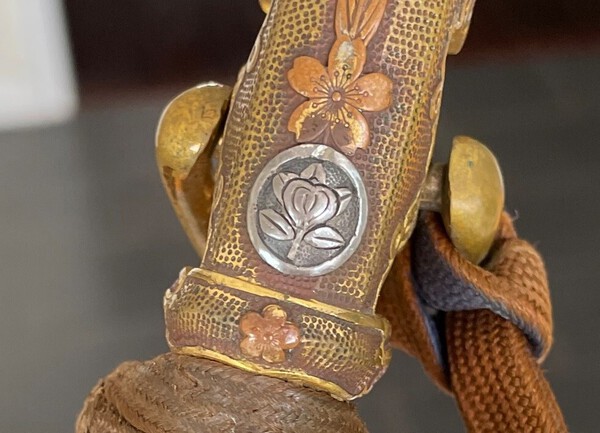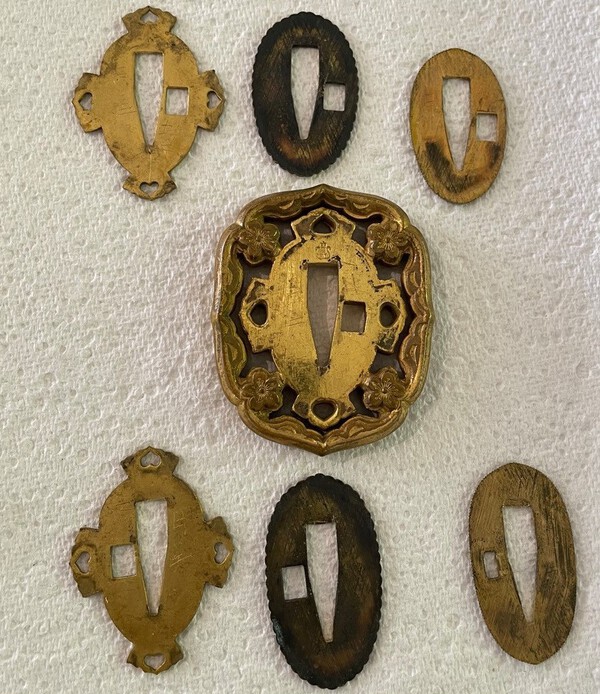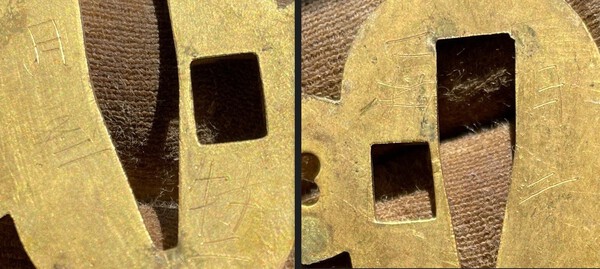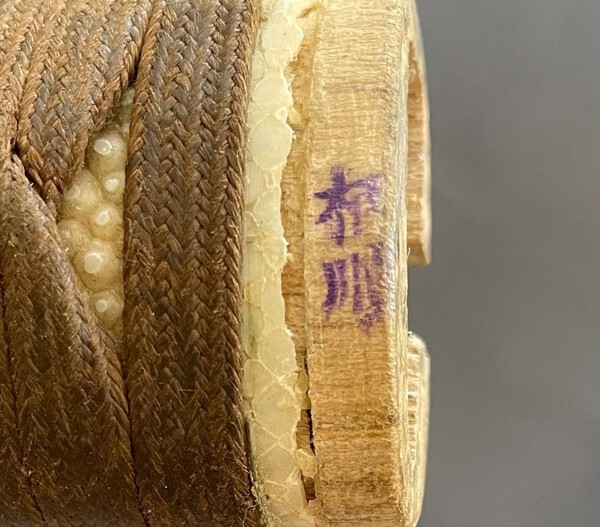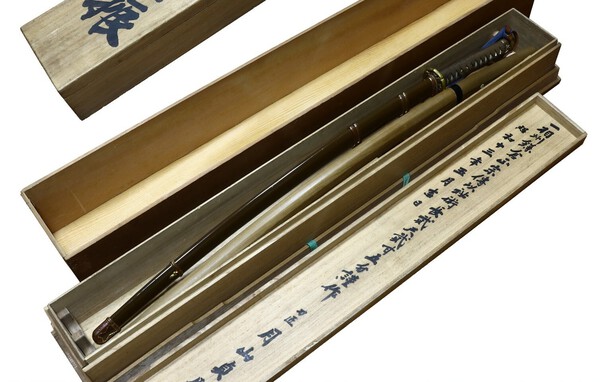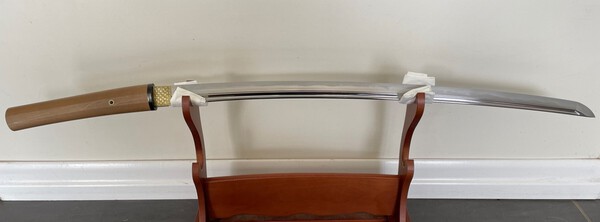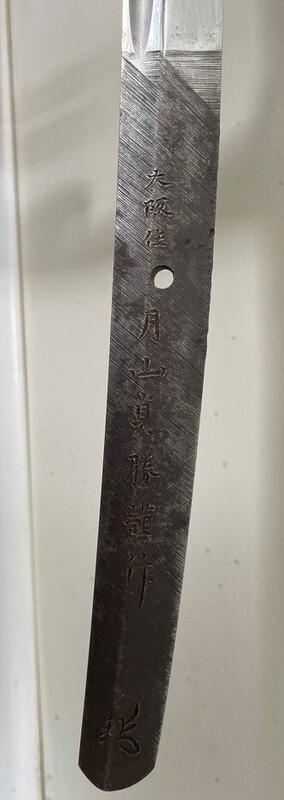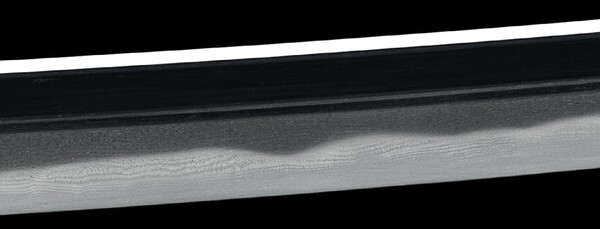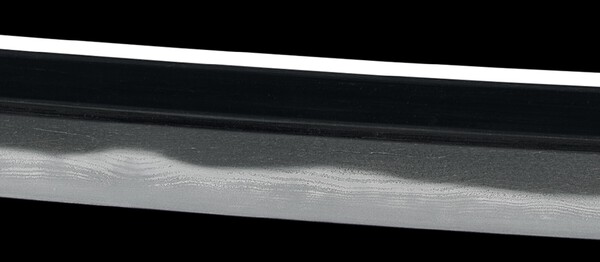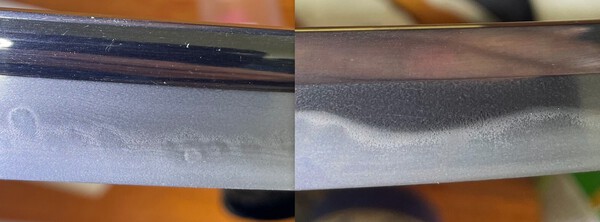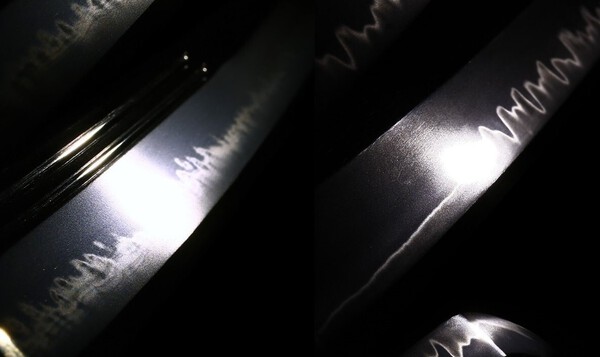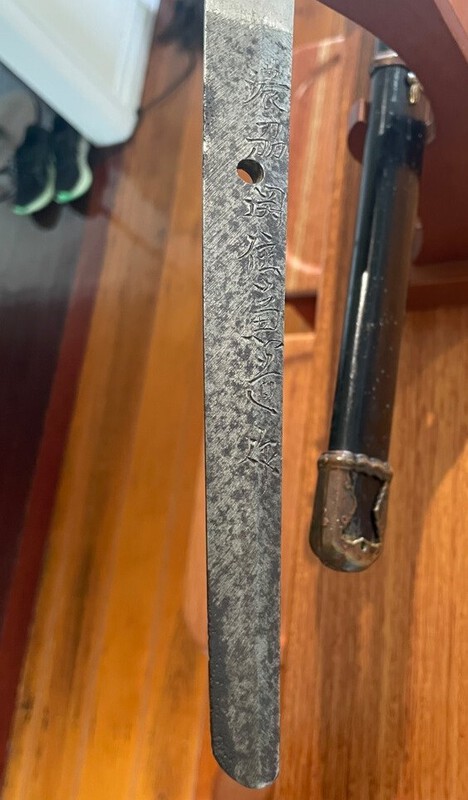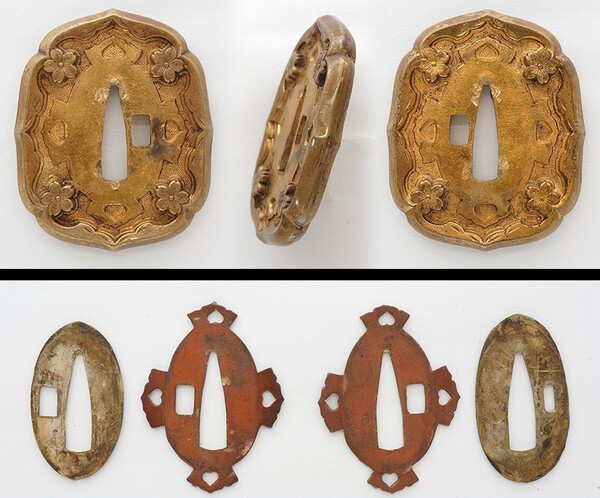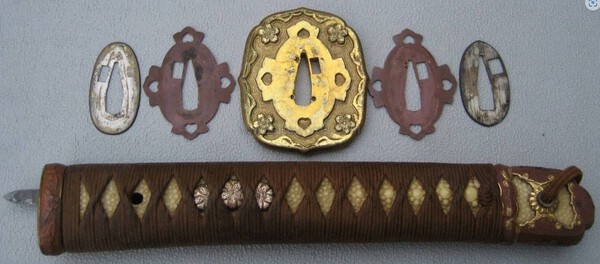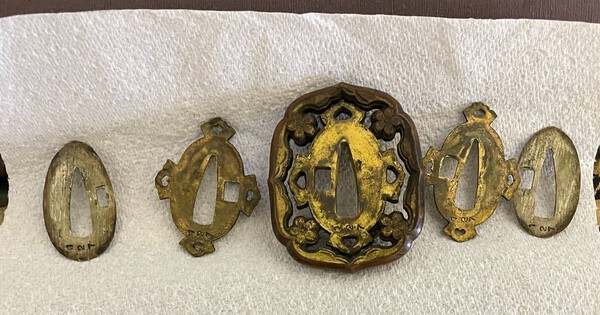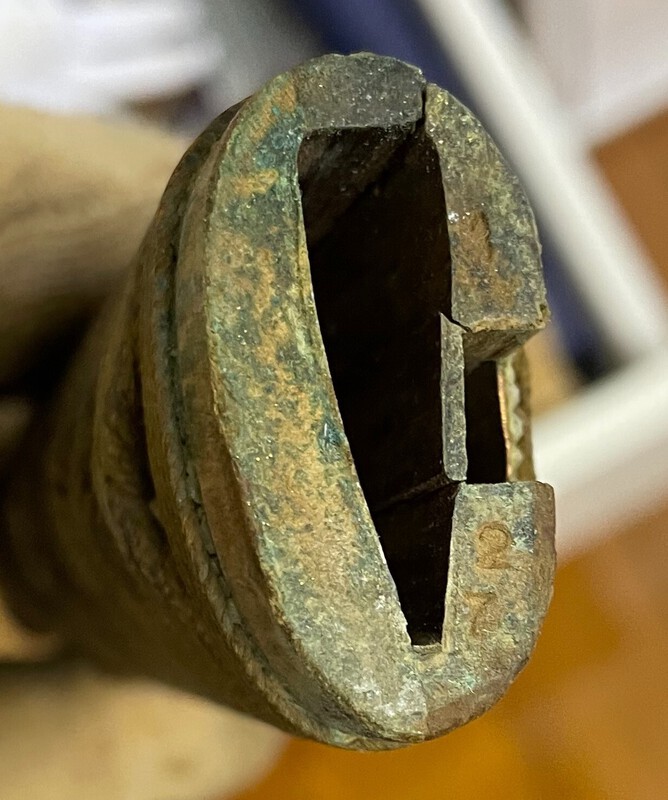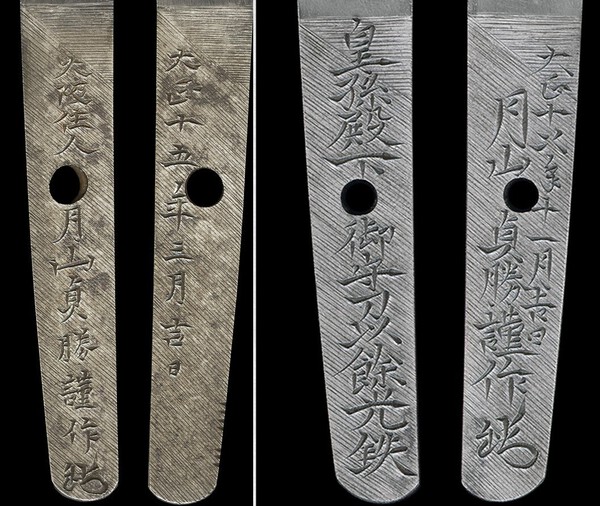-
Posts
739 -
Joined
-
Last visited
-
Days Won
14
Content Type
Profiles
Forums
Events
Store
Downloads
Gallery
Everything posted by Bryce
-
G'day Guys, The following are from a shin gunto koshirae made for a Gassan Sadakatsu blade. The fittings all have these matching markings which I think are 月 2 特. I think the 月 is short for Gassan , 2 an assembly number and 特 something to do with special? Am I on the right track? In addition the tsuka has kanji in purple ink which may have something to do with the maru ni tachibana mon on the kabutogane. Cheers, Bryce
-
Thanks John, It has a maru ni tachibana mon. I guess that first kanji could be tachibana? Cheers, Bryce
-
That last kanji may be 特 special? Cheers, Bryce
-
On a Japanese auction site I found an almost identical set of koshirae, that was sold as being from a Gassan Sadakatsu blade. The tsuba on this set also had the Suya Shoten stamp. The fittings all had similar markings which appear to be 月山 3. I guess the markings on mine are similar but the 月山 has been shortened to just 月. I am not sure what the last kanji stands for. I wonder if Suya Shoten were Gassan Sadakatsu's koshirae supplier of choice? Cheers, Bryce
-
No worries Bruce. The fittings are all similarly marked, but I think it is more than just a number. The tsuba has the Suya Shoten stamp. I am sure I have seen an ink stamp on the tsuka like this before, but don't know where. Anyone have any ideas? Cheers, Bryce
-
G'day Bruce, I am not sure I follow you? The nagasa is 68.5cm. Cheers, Bryce
-
G'day Guys, Tanto by Gassan Sadakatsu are often found in their original boxes complete with hakogaki. It is much rarer to find his long blades still in their original box. Here is an example still in the box, with hakogaki by Sadakatsu attesting that it was made using Masamune's secret process. Even better is the fact that the original type 94 shin gunto koshirae is still with it. When someone ordered a blade and koshirae from Gassan Sadakatsu, this is how they would have received it. It is dated May 1938. Cheers, Bryce
- 67 replies
-
- 14
-

-

-

-
G'day Guys, Just to add to this thread, I have documented 7 katana commemorating this occasion. I have probably seen at least the same number of tanto, although I haven't kept records of these. The 7 katana I have documented are all very similar, all signed the same way and done in ayasugi. As mentioned in other threads, Sadakatsu was a marketing genius as well as a fantastic smith. Cheers, Bryce
-
G'day Arik, Actually it says Gassan Sadakazu, but it was probably signed by Sadakatsu for his father Sadakazu. I would love to see photos of the whole blade. Cheers, Bryce
-
Thanks guys, When you look at the huge differences that can be achieved using water as the quenching agent, I imagine that a similar range of results may be possible using oil as the quenching agent? Where I am going with this is that in the military swords forum a common question is "is this an oil quenched blade?" Some blades are obviously oil quenched, some blades are obviously water quenched, but I bet there are many blades where it is impossible to know with certainty, what quenching medium was used? Cheers, Bryce
-
These are what the blades look like under direct light. Sadakatsu on left and Sukenaga on right. The Sadakatsu has much finer nie (konie) than the Sukenaga. Cheers, Bryce
-
G'day Guys, Can anyone tell me how different hamon types are produced? I am not thinking of the shape of the hamon, but specifically why did Gassan Sadakatsu produce a hamon with a very thick nioiguchi, while Yokoyama Sukenaga produced a thin hamon like a laser beam? I know that a thick nioiguchi is generally regarded as desirable, but why? What characteristics do each of these hamon types impart to the steel? Below is a photo comparing a Gassan Sadakatsu hamon to one by Bizen Sukenaga. Cheers, Bryce
-

looking for different signatures of Kojima Kanemichi Gendai
Bryce replied to Volker62's topic in Military Swords of Japan
One thing I have noticed about Kanemichi, is that I think he must have had a bunch of different people signing his blades for him. There is an awful lot of variation amongst his mei. Cheers, Bryce -

looking for different signatures of Kojima Kanemichi Gendai
Bryce replied to Volker62's topic in Military Swords of Japan
G'day Volker, Here is a shot of the whole sword. The 67cm blade appears to be in its original polish. The hada is masame and the hamon is a noi-deki, sanbonsugi, with small ashi. I can't see any activity within the hamon. The nakago inscription says it was ordered by Mr Minoru Nokura to commemorate the first anniversary of the start of the pacific war (basically the bombing of Pearl Harbour). Cheers, Bryce -

looking for different signatures of Kojima Kanemichi Gendai
Bryce replied to Volker62's topic in Military Swords of Japan
G'day Volker, Here is another different one. The "Michi" is very abbreviated. No stamps and dated December 8, 1942. Cheers, Bryce -

Attention Mantetsu Owners: A Survey
Bryce replied to Bruce Pennington's topic in Military Swords of Japan
Can anybody else provide information on mantetsu blade measurements and how much they vary? Cheers, Bryce -

Attention Mantetsu Owners: A Survey
Bryce replied to Bruce Pennington's topic in Military Swords of Japan
G'day Guys, Here are a couple of sets from a 1941 mantetsu from AOIJapan and a 1943 from Artswords. Cheers, Bryce -

Attention Mantetsu Owners: A Survey
Bryce replied to Bruce Pennington's topic in Military Swords of Japan
G'day John, I am not sure at all. I am just basing this on the fact that koa isshin mantetsu's appear to have a rounded back to the nakago and the tsuba and seppas on my koshirae are made to accommodate a nakago with a rounded spine. I haven't seen this feature on any other blades. I have never handled one, so I could be wrong. Cheers, Bryce -

Attention Mantetsu Owners: A Survey
Bryce replied to Bruce Pennington's topic in Military Swords of Japan
G'day Guys, I have never owned a Mantetsu and know very little about them. I would like to know if the Mantetsu blade measurements vary much? The reason I ask is that I think I have accidentally come into possession of a nice set of Mantetsu koshirae and was wondering what the chances of them fitting a random Mantetsu blade were? Cheers, Bryce -
-
G'day Alan, I don't know anything about Kanenori and will look into him as you have suggested. Cheers, Bryce
-
G’day Guys, I was a bit surprised by the pushback I received about this topic. One of the most asked questions on this forum is “is my blade gimei?” and there are usually no shortage of eager volunteers ready to shout “gimei!”. What I was trying to show is that this is a very complex question. Smiths changed the way they signed over time and at any given time there may have been more than one person signing for the same smith. In the case of Gassan Sadakatsu there were at least two people (including him) signing his blades. You cannot compare any mei to a single oshigata and decide it is gimei. So what if Sadaichi was signing some of Sadakatsu’s blades, they are still shoshin. As far as I know this was common practice across all schools, across all time. I have seen no evidence that Sadakazu was a better smith than Sadakatsu, or that Sadakatsu was a better smith than Sadaichi. I wonder if some of the criticism I have received was because of a theory that early Sadakatsu blades were somehow better than later ones. Again I have seen no evidence of this. A blade from 1943 is every bit as good as one from 1933. I have also seen several Tanobe sayagaki for Gassan School blades where he has stated that it was the work of the son, rather than the father as signed, so he has no problem with disclosing that information. Cheers, Bryce
-
G'day Neil, I only have bits of the book, not the whole thing. Any good? Cheers, Bryce
-
G'day Neil, This entire hobby is based on opinion and speculation, because the people involved in the production of these blades are all dead. What you are really asking is why anyone should take notice of my opinion. Fair enough, there is nothing wrong with healthy skepticism. I have focused on studying Gassan Sadakatsu blades for the last two years. I am not asking you to just believe me. Look at the evidence I have posted and make your own conclusions. Below are some further comparisons, signed by Sadakatsu on the left and Sadaichi on the right. These are tantos dated 1925 and katanas dated 1921 and 1926. These are all papered by the NBTHK to Sadakatsu. Lastly I will finish up with a comparison of a Sadakatsu tanto dated 1933 on the left and one dated 1940 on the right. Yes there are some changes in his mei over time, but the basics of how he forms his kanji doesn't really change. Interestingly the spine of the nakago on the 1933 tanto was signed by Sadaichi who carved the horimono. Remember, I am only saying these were signed by Sadaichi for his father. I am not saying these were made by Sadaichi. Sadaichi being his father's apprentice would have been involved in the production of all of his father's blades in some form. Cheers, Bryce
-
G'day Guys, Someone asked me what date Sadakatsu daimei/daisaku by Sadaichi began to appear. The answer is very early on. The earliest blade I have seen to date, which I believe was signed by Sadaichi for his father, was dated 1925. Below are two Gassan Sadakatsu signed tanto blades dated 1933. The one on the left was actually signed by Sadakatsu. The blade on the right I believe was signed by Sadaichi for his father. Cheers, Bryce





